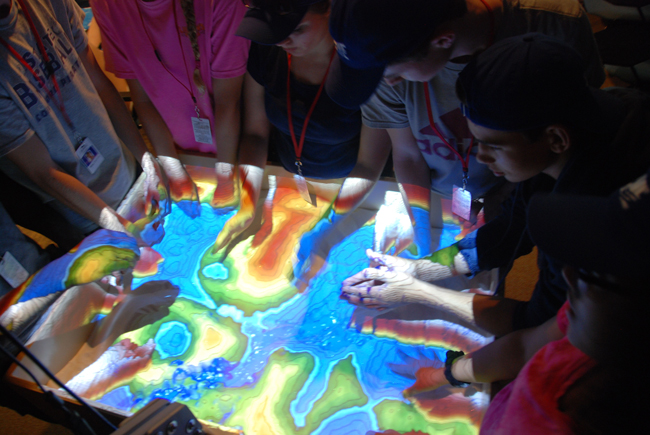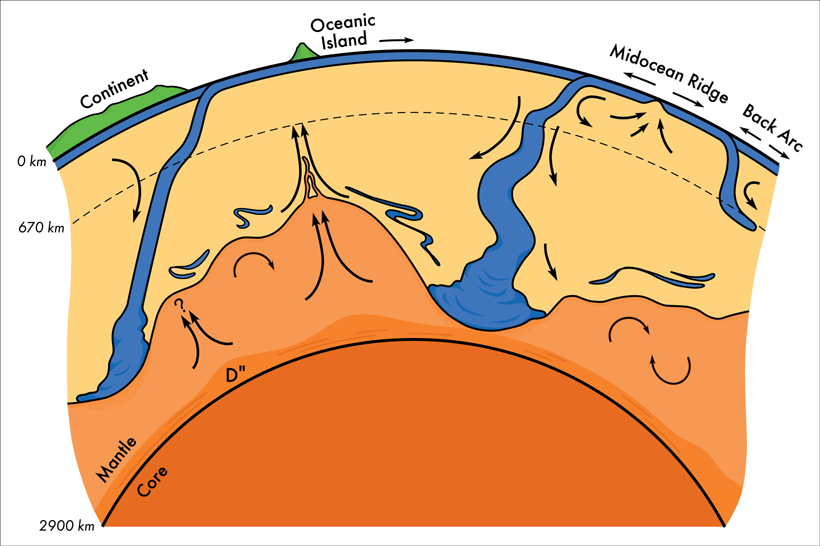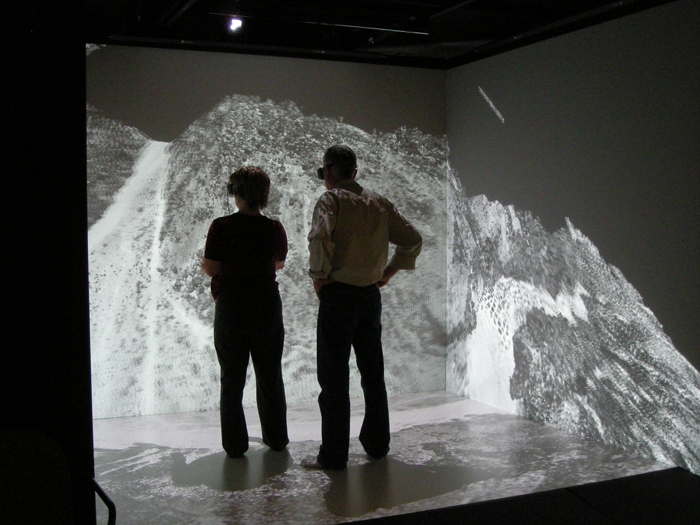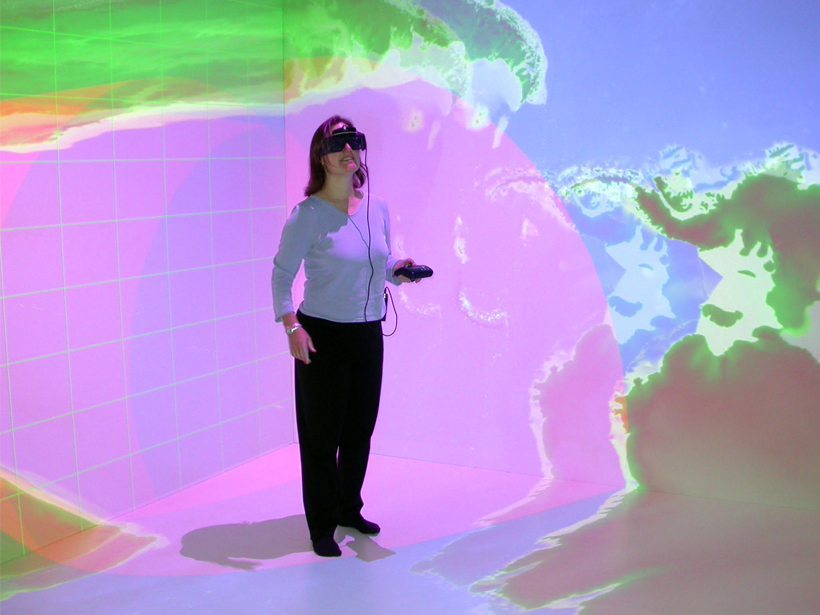This article is part of a Centennial series recognizing eminent Earth and space scientists. Our series presents scientific journeys, as well as “family portraits” of the luminaries and their scientific progeny—the students, postdocs, and collaborators who have received inspiration, encouragement, and guidance from these leading lights of science.
Learn more about the lasting legacies of Warren M. Washington, Mary Pikul Anderson, and Louise Kellogg.
Louise Kellogg, a geoscientist who studied Earth’s interior, may be best known in some circles for designing a sandbox.
The Augmented Reality Sandbox that Kellogg and her colleagues created to teach the public about Earth science is just one example of her commitment to teaching and outreach, a passion she balanced with lauded research recognized by AGU, the American Academy of Arts and Sciences, and the American Association for the Advancement of Science (AAAS), among other organizations.

Kellogg, a professor of Earth and planetary sciences at the University of California, Davis, died on 15 April at the age of 59 from complications from breast cancer.
Kellogg grew up in Silver Spring, Md. She earned both her undergraduate and graduate degrees—in engineering physics/philosophy and engineering physics/geological sciences, respectively—from Cornell University in Ithaca, N.Y.
Donald Turcotte, a geophysicist and Kellogg’s graduate adviser, remembers her as smart and driven. She was the only woman in Cornell’s undergraduate physics program, he recalls, and she did just fine despite male students refusing to work with her on problem sets.
“I basically recruited her to be my graduate student,” said Turcotte, who was then the chair of the geology department. In 1983, Kellogg began working with Turcotte studying convective mixing in Earth’s mantle.
One year before Kellogg defended her Ph.D. dissertation, she and Turcotte traveled to France at the request of Claude Allègre, a leader in the field of isotope geochemistry working at the Institut de Physique du Globe de Paris. Allègre, along with Turcotte, had recently developed a “marble cake” model of the mantle in which strips of subducted oceanic crust stretch and thin over time. The two senior scientists were looking for someone to quantitatively justify their model, which was where Kellogg came in.
“Louise was one of the early thinkers who wanted to learn to combine geochemistry with geophysics.”
“Claude was extremely happy with the work that she did,” said Turcotte.
Allègre’s praise helped Kellogg secure her first job after graduate school, a postdoctoral position at the California Institute of Technology (Caltech) in Pasadena. There, she worked with another renowned geochemist, Gerald “Jerry” Wasserburg, studying how helium is transported through the mantle.
Kellogg’s experience with both geophysics and geochemistry research differentiated her from other scientists, said Robin Reichlin, director of the Geophysics and Cooperative Studies of the Earth’s Deep Interior program at the National Science Foundation (NSF).
“Louise was one of the early thinkers who wanted to learn to combine geochemistry with geophysics,” said Reichlin, who knew Kellogg for over 20 years.
Career as a Mentor
While she was working with Wasserburg, Kellogg also spent time mentoring more junior scientists.
Scott King, a geophysicist now at Virginia Polytechnic Institute and State University (Virginia Tech) in Blacksburg, was a graduate student at Caltech when Kellogg was a postdoc. He remembers Kellogg reading over his research statements when he was searching the job market. “We were actually even applying for some of the same jobs,” King said.
Today, King pays Kellogg’s generosity forward by baking “planet cakes”—hemispherical cakes with layers that represent the Earth’s inner core, outer core, mantle, and crust—and bringing them to schools to engage students in Earth science.
Kellogg would have approved of these cakes, King said. “She was always looking out for ways to help people understand about the Earth’s deep interior, so I’m sure she would have liked them.”
After spending 2 years at Caltech, Kellogg accepted a position as an assistant professor in the Geology (now Earth and Planetary Sciences) Department at the University of California, Davis, in 1990.
A little more than a decade later, by which time Kellogg had received tenure at Davis and was department chair, she would help hire Turcotte, her thesis adviser at Cornell.
“I was fed up with the snow—I was 70 years old,” said Turcotte. “She arranged for me to get a half-time professorship.”
The Kellogg Model and Earth Rhythms
At Davis, Kellogg continued to study Earth’s interior, specifically, its mantle. Kellogg summed up why the mantle matters at AGU’s Fall Meeting 2018 in a special plenary session focused on scientific breakthroughs of the past 100 years.
“[Convection in the mantle] cools our planet, drives the motion of the tectonic plates, creates the ocean basins and the continents, and, by shaping the surface, makes possible life on Earth,” Kellogg said during the session.
Kellogg’s most cited publication, “Compositional Stratification in the Deep Mantle,” was published in Science in 1999. Along with collaborators at the Massachusetts Institute of Technology, Kellogg proposed a model of Earth’s interior in which the mantle experiences strong chemical stratification at a depth of roughly 1,600 kilometers. Because different minerals are characterized by different densities, this stratification results in a “boundary” between the upper and lower mantle. The location of this boundary proposed by Kellogg and her colleagues is roughly 3 times deeper than previously suggested. This model satisfies the essential geochemical and geophysical observations, Kellogg and her colleagues wrote in Science.
Even now, 2 decades after it was published, this model is still frequently referenced.
“I still see the Kellogg model put up on screens at meetings all the time,” said Reichlin, who worked with Kellogg through NSF. “It’s had a hugely influential place in our thinking about the Earth’s deep interior.”

Kellogg’s research garnered awards and recognition from AGU, NSF, AAAS, then president George H. W. Bush, and the University of California, among others.
Dawn Sumner, an Earth scientist at the University of California, Davis, remembers Kellogg as an accomplished scientist and also a generous mentor.
“She was someone who was always concerned about the well-being of other people.”
“She did a huge amount of mentoring for early-career faculty,” said Sumner. “She was someone who was always concerned about the well-being of other people.”
Sumner, who was hired at Davis a few years after Kellogg, became close friends with the more senior scientist. Sumner remembers frequently asking Kellogg for advice about the tenure process and how to work effectively with colleagues who were strongly opinionated. “She was always willing to talk,” said Sumner.
Kellogg and Sumner also shared an interest beyond science: Both of the women enjoyed modern dance, and they took classes together at a dance studio close to the Davis campus. Fittingly, one of the classes Kellogg and Sumner enrolled in was called Earth Rhythms.
A Leader in the Geosciences
The geoscience community benefited in many ways from Kellogg’s service. From 2010 to 2019, she was the director of Computational Infrastructure for Geodynamics, an organization that develops and shares geophysics-related software. She also served as the associate editor of the Journal of Geophysical Research (1992–1995), the tectonophysics editor of Eos (1993–1995), the editor of Reviews of Geophysics (2001–2004), and the Tectonophysics section secretary (1998–2000).
Kellogg was strongly committed to training the next generation of scientists.
In 2003, she helped found the Cooperative Institute for Deep Earth Research (CIDER). A self-described “inter-disciplinary synthesis center, research incubator, and research framework for tackling the fundamental question of the nature of global geodynamic processes,” CIDER became CIDER-II (the Cooperative Institute for Dynamic Earth Research) in 2012.
Kellogg was an early promoter of data visualization in the Earth sciences.
Notable among CIDER-II programs is a summer program that brings together junior and senior scientists in a multiweek program consisting of lectures, tutorials, and workshops. The 2019 program—the 13th summer program—was held at Berkeley with over 75 participants from the United States, Chile, the United Kingdom, Australia, France, Germany, China, and Sweden.
Kellogg was also an early promoter of data visualization in the Earth sciences. Scott King, Kellogg’s colleague from Caltech, remembers talking with her about a meeting session she attended that focused on color palettes for displaying data. “It was a session she really found inspiring,” said King.
In 2002, Kellogg and other researchers started brainstorming what would become the W. M. Keck Center for Active Visualization in the Earth Sciences (KeckCAVES); she served as its director from 2004 until her death.

The showpiece of the center, housed in the Earth and Physical Sciences Building on the University of California, Davis, campus, is a facility known as the CAVE. It consists of three 3- × 2.4-meter (10- × 8-foot) walls and a 3- × 2.4-meter floor that display three-dimensional images. A wide variety of data can be projected, including measurements related to planetary geology, plate tectonics, and oceanography.
“The creative science that emerged from that collaboration changed my view of science,” Sumner wrote on a web page called Memories of Louise set up by the Davis Department of Earth and Planetary Sciences.
KeckCAVES, in partnership with another University of California, Davis–based research center and other science centers, also developed a portable version of its three-dimensional data visualization technology. The result, the Augmented Reality Sandbox, combines the tactile nature of sand with a projection system that lays down a color-coded elevation map, topographic contour lines, and simulated water on whatever sand formations users create.

“With its hands-on, interactive technology, the Augmented Reality Sandbox is well suited for education and outreach,” Kellogg said in 2016.
Instructions for creating the Augmented Reality Sandbox are freely available online, and the team that developed it estimates that over 700 copies have been made. (Confession: I played with an Augmented Reality Sandbox at my local science museum in Portland, Ore.!)
Kellogg’s numerous contributions to the geoscience community—her award-winning science, the mentorship she provided to student and early-career researchers, and her support for data visualization and science communication—will live on in spirit. The programs and organizations she helped found—the Cooperative Institute for Dynamic Earth Research, KeckCAVES, Computational Infrastructure for Geodynamics, and others—will continue.
“She put her efforts into so many areas,” said NSF’s Reichlin. “She’s contributed so much to the science enterprise.”
—Katherine Kornei (@katherinekornei), Freelance Science Journalist
Citation:
Kornei, K. (2019), Louise Kellogg: Geoscientist, mentor, science communicator, Eos, 100, https://doi.org/10.1029/2019EO134555. Published on 01 October 2019.
Text © 2019. The authors. CC BY-NC-ND 3.0
Except where otherwise noted, images are subject to copyright. Any reuse without express permission from the copyright owner is prohibited.

